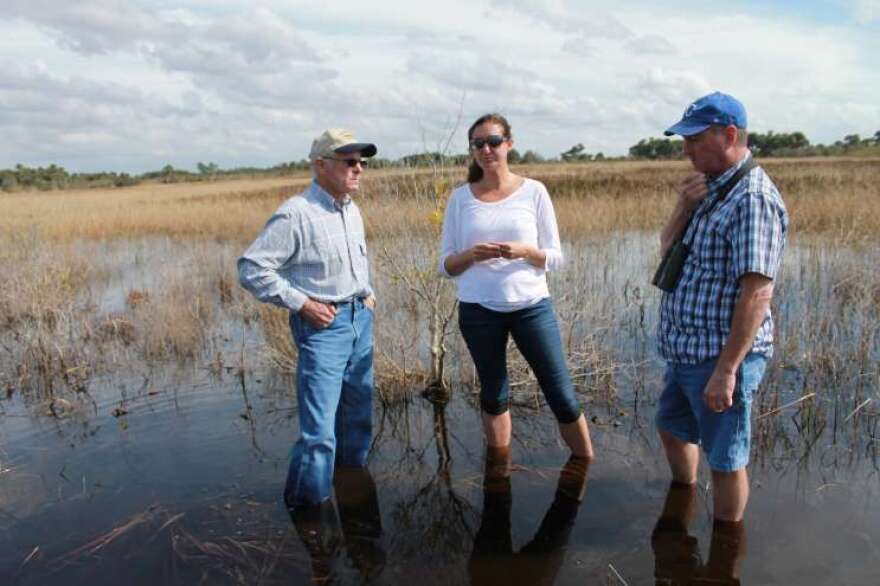There’s a multi-billion-dollar plan to protect Florida’s Everglades. But progress has been slow, and that's raised concerns. 90.7’s environmental reporter Amy Green visited the headwaters of the Everglades right here in central Florida to see what’s been done to protect the river of grass.
___
The water is brown but clear, colored like tea by the vegetation springing from it, scattered tufts of grass and in the distance hammocks of cabbage palm, Florida's state tree.
"If you just stand there for a little bit you'll notice the water is actually moving, and it's moving like one-tenth of a foot per minute or something. It's very, very slow. But this water is actually flowing."
Paul Gray of Audubon of Florida says the important thing is that it flows. After falling from the sky the water drifts slowly toward the Kissimmee River, which delivers it to Lake Okeechobee, the state's largest lake. From there some of the water heads toward the Everglades.
A river of grass. Gray is standing with bare feet in the headwaters.
"Florida was so wet for so long that the interior is still largely undeveloped."
He says developing this land would undermine Everglades restoration to the south.
"Nobody could really live in here because it was so wet. Nobody could stand it. And so we're at a moment in history when Florida is developing rapidly, but we still have the good ol' stuff left. And either we save it now or once it's gone it's gone."
When federal leaders announced plans five years ago for the Everglades Headwaters National Wildlife Refuge and Conservation Area, they described it as a novel approach aimed at protecting the wellspring of the Everglades and a generations-old ranching way of life.
A restoration of the Everglades south of Lake Okeechobee had been underway for many years, but for the first time leaders turned their attention to the watershed's headwaters, in a region distinguished by vast ranchlands and threatened by advancing development. Many worried about pollution here gushing toward the Everglades, which supports dozens of federally threatened and endangered species and the drinking water for more than a third of Floridians.
The goal was to protect the Everglades from its beginning while partnering with ranch owners through agreements called conservation easements. The easements would allow ranch owners to continue working their land while saving it from future development.
Lefty Durando is a rancher in the Everglades' headwaters.
"We really need to keep Florida lands in the beef business. We are one of the largest producers of beef in the United States."
At 150,000 acres the refuge would rank among the state's largest, reaching from south of Orlando to near Lake Okeechobee. The plans sat dormant until recently, and more acquisitions are expected soon. But with meager funding and no timetable for completion many wonder whether the refuge can outpace development.
Julie Morris is working on the refuge on behalf of the National Wildlife Refuge Association.
"The conservation community, we've always been in a race against time, and I can't think of any other place in the country that has such a high amount of biodiversity that's under such siege."
Touring in a swamp buggy with rancher Lefty Durando we see cattle graze. A mother nuzzles her calf. We see alligators, sandhill cranes, turkeys, an otter. A white-tailed deer gallops. Its hooves send water flying with their percussive strikes.
"Now if I do what has normally happened in Florida, and that's why we're in the trouble we're in in the south Everglades, if we build houses all of this gets ditched and all of this water gets to the Kissimmee River a lot quicker and a lot dirtier."
Something Durando never wants to see happen to this land that for decades he's protected from development.


